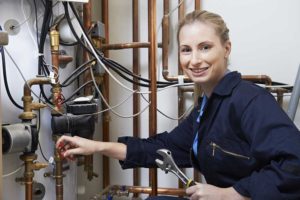Disclaimer: The information on our website is provided for general information purposes only. We make no representations or warranties of any kind, express or implied, about the completeness, accuracy, reliability, suitability or availability with respect to the website or the information contained on our website for any purpose. Any reliance on such information is therefore strictly at your own risk and we are not liable for any damages or losses arising out of or resulting from your reliance on any information contained on our website.
A plumber installs or repairs pipes and fittings that carry liquids and gases. They troubleshoot dysfunctional pipe systems and repair or replace worn parts. They sometimes cut holes in floors, ceilings and walls and may need to hang steel supports from ceiling joints to hold the pipes in place which usually requires fitting, measuring and cutting pipes to fit using pipe cutters and saws. When working with copper pipes, soldering may be required.
Watch a video to learn what a plumber does.
How to Become a Plumber

Plumbers need a high school diploma or equivalent. Many employers give on-the-job training. However, attending technical school with courses in pipe system design along with safety and tool use can be beneficial as well. Welding courses are also given in apprenticeship training programs.
A plumbers apprenticeship program usually takes 4-5 years to finish. After an apprenticeship program is completed they are considered to be journey workers. With additional years of experience and other courses, they would become eligible to be considered master status. Most states and localities require you to have a license to work.
Job Description of a Plumber
A plumber works in factories, businesses and homes with each job varying in size, like, large water lines to buildings or small water lines to refrigerators. They also install plumbing fixtures or toilets, as well as, water heaters, dishwashers and other plumbing requirements. Their job would include unclogging pipes, fixing leaks or maintaining septic systems that are not connected to city or county sewer systems.
A master plumber would normally work on larger, construction projects and would need to read the blueprints detailing all pipe and fixture locations while meeting any building codes or regulations, as well as, location of electrical wiring. They are responsible to stay within a given budget and time schedules. The Bureau of Labor Statistics projects growth in this career field due to new building construction and stricter water efficiency standards for plumbing systems.
Plumber Career Video Transcript
Plumbers, pipefitters, and steamfitters keep civilization in running water, sanitation, and heat for comfort and cleaning. Plumbers, pipefitters, and steamfitters install and repair pipe systems to transport water, chemicals, and waste. They use saws to make holes in floors and walls and pipe cutters to size pipe accurately. Plumbers work on water, drainage, and gas pipes in homes and businesses. They also install plumbing fixtures and appliances. They rescue homeowners from leaks, clogged drains, and malfunctioning septic systems.
Pipefitters install and repair pipes that carry chemicals, acids, and gases— usually in power plants and industrial settings. Some install fire sprinkler systems. Steamfitters install pipe systems that move steam under high pressure; most work at college campus facilities and natural gas power plants. With high rates of injury on the job, precautions must be taken with common tasks such as lifting heavy materials, handling tools, and climbing ladders. Work schedules are full time, and may include nights, weekends, and emergency calls.
A 4 to 5-year apprenticeship is typically required, combining paid on-the-job training with classroom study. A license is generally required for plumbers, and some states license pipefitters and gas line workers. Helpers assist experienced trades professionals, haul tools and materials, and clean work areas. They typically have a high school education, and learn on the job.
Article Citations
Bureau of Labor Statistics, U.S. Department of Labor, Occupational Outlook Handbook, Plumbers, Pipefitters, and Steamfitters.
National Center for O*NET Development. 47-2152.02. O*NET OnLine.
The career video is in the public domain from the U. S. Department of Labor, Employment and Training Administration.

